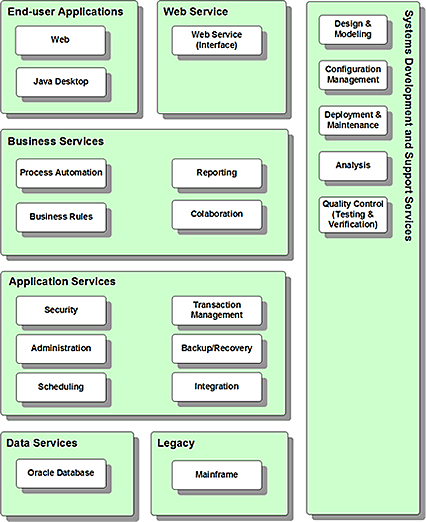Service Oriented Architecture (SOA)
Overview
 A service-oriented architecture is defined as an architectural strategy that seeks to segment and isolate critical application and data functionality and access into small, operationally independent pieces that can be executed remotely and in a highly distributed manner. The end goal of a service-oriented architecture is to provide easy and secure access to enterprise technology and process resources, maximizing re-use and minimizing cost, while improving the performance and reliability of these systems.
A service-oriented architecture is defined as an architectural strategy that seeks to segment and isolate critical application and data functionality and access into small, operationally independent pieces that can be executed remotely and in a highly distributed manner. The end goal of a service-oriented architecture is to provide easy and secure access to enterprise technology and process resources, maximizing re-use and minimizing cost, while improving the performance and reliability of these systems.
- End-user Application Interface / Portal – This layer provides users and external systems a common way of communicating and interacting with business processes and applications. Users see a one-stop-shop experience within a cohesive suite of utilities and applications. This common interface reduces the overhead of user training. Overhead associated with application integration and maintenance is also reduced.
- Business Services –The business layer contains back-office, or server-side, application components. Users connect to these services via end-user applications (Graphic User Interfaces – GUIs). A feature provided by this configuration is centralized administration. With common application interfaces, business service components are centralized for administration.
- Application Services – Application components are managed in this layer to ensure that they are secure and available to other parts of the architecture when needed. Provided are monitoring and control functionality across all integrated systems. This feature enables non-IT resources administrative access.
- Data Services – The data services layer isolates the organization from changes in the underlying data systems and applications, as well as providing a unified approach for accessing the data and functionality from those systems.
- Legacy - The legacy layer is like the services in that it isolates the organization from changes in underlying legacy applications, as well as providing a unified approach for accessing functionality from those systems. The legacy layer includes replication services supporting synchronization between current (e.g. Oracle) and mainframe data stores.
- System Development and Support Services - This service area provides the following benefits:
- Design and model business processes and system interaction
- Assemble and develop applications from existing components
- Deploy and maintain applications in a production environment, even if the components are distributed
- Analyze and optimize processes and application infrastructure, based on data gathered by the event services layer
Copyright ©2007 Gary Samuelson, All Rights Reserved.
